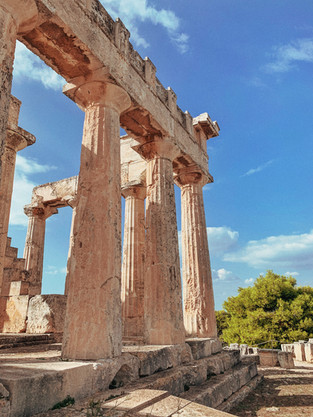𝕋𝕖𝕞𝕡𝕝𝕖 𝕠𝕗 𝔸𝕡𝕙𝕒𝕚𝕒, 𝔸𝕚𝕘𝕚𝕟𝕒
- Μαρία Κόρμπου
- Jan 14, 2021
- 2 min read
The temple of Aphaia is located in the northeast side of the island of Aigina in the Saronic gulf.
Mysterious remains the ancient geometry that connects this temple with the Parthenon and the temple of Poseidon in Sounion forming an isosceles triangle.
Another triangle also connects it to Parthenon and the temple of APollo at Delphi.
As we see it today it was built between 500-490 BC although worship of a female deity was taking place since the Myceanaean period.
Its decline begun already in the mid 5th century due to the Athenian dominance over the island of Aigina.
By the 2nd century BC the area was almost completely abandoned.
The temple is Doric in style, peripteral (meaning all collumns around, 32 to be exact) and has 6 collumns on the short and 12 on the long side.
On the triangle formed over the collonade and under the roof on the short side, called the pediment, there are scenes from the Trojan War.
Unfortunately all the elaborate sculptures are kept far away in Munich Glyptothek. The east and the west pediments are very different since they were created with 10 years difference.
Many heroes who fought in the great war of the Greeks originated from Aigina so the theme was appropriate.
The east pediment is the youngest, dating 480 BC, and its style shows the naturalism of the classical era on the bodies of the warriors.
The west pediment is the oldest, dating 490BC, showing features of the stylized archaic style. Its central figure is Goddess Athena as a warrior in her full armor, shield and spear.
Due to this prominent depiction of Athena, many have misinterpreted the temple as devoted to her. But the temple is devoted to a very local deity named Aphaia or the one who disappeared.
The myth starts in the island of Crete with the daughter of Zeus, Britomartis. She was very dear to Artemis since she was the female deity of hunting and fishing in ancient Crete.
Minos fell in love with her and tried to seduce her. Fleeing from him, she took refuge among fishermen's nets and safely arrived at Aigina.
Artemis made her a goddess and Cretans worshiped her as Dictynna (literally goddess of nets). After her escape from Minos and arriving at Aigina she disappeared from sight and became APHAIA (not to be seen).
So she is more closely identified with Artemis than Athena. Due to her associa
tion with nets and fishing, playing a major role in island diet and prosperity, she was very dear to both the islands of Crete and Aigina.
As it is custom, through the points in time and space, different deities take different names and types of worship.
Aphaia - Britomartis - Dictynna were all dear to goddess Artemis due to their connection to nets and fishing being a part of the activity of hunting.








Comments